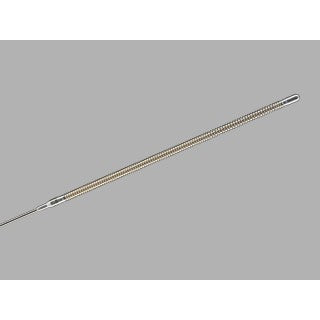Description
Cook Medical G21962 - WIRE GUIDE, SAVARY-GILLIARD, SGW-250-SD, EACH
Savary-Gilliard Wire Guide
This device is used to introduce the Savary-Gilliard Dilator.
Notes: This device is supplied non-sterile and is reusable if the device integrity is intact. Do not use this device for any purpose other than stated intended use. If the package is opened or damaged when received, do not use. Visually inspect with particular attention to kinks, bends and breaks. If an abnormality is detected that would prohibit proper working condition, do not use. Please notify Cook for return authorization. Store in a dry location, away from temperature extremes.
| Order Number | Reference Part Number | Wire Guide Length (cm) | Tip Shape | Wire Type |
| G21962 | SGW-250-SD | 250 | Progressively Flexible | Stainless Steel |
Technical Features
| ETO Cycle Parameters Parameter | Set Point |
| Prevacuum Pressure | 2.0 psia (25.9" Hg Vac) |
| Relative Humidity | 60% RH |
| Humidity Dwell | 20 minutes |
| Chamber Temperature | 54.4℃ (130℉) |
| Exposure Pressure | To Be Determined1 |
| Exposure Dwell | 2 hours |
| ETO Concentration | 600 mg/L |
| Post Vacuums | 3 |
| Post Vacuum Pressure | 2.0 psia (25.9" Hg Vac) |
| Air Wash2 | 5 minutes |
| Aeration Temperature | 54.4℃ (130℉) |
| Aeration Dwell | 12 hours |
| Air Changes During Aeration | 90 per hour |
- 1To be calculated by the Institution to achieve an ETO concentration of 600 mg/L.
- 2Repetitive vacuums from ambient pressure to 13.7 psia over 5 minutes.
Note: ETO sterilizer chamber loading should not exceed 11 products per cubic foot of chamber space or exceed the usable chamber space. If any damage to a product is noted prior to sterilization, the product should be taken out of service immediately.
| Autoclave Cycle Parameters Parameter | Set Point |
| Cycle Type | Prevacuum |
| Prevacuum Pressure | 2.5 psia (24.8" Hg Vac) |
| Chamber Exposure Temperature | 132.2℃ (270℉) |
| Chamber Exposure Pressure | 41.8 psia (27.1 psig) |
| Exposure Dwell | 5 minutes |
Note: Autoclave chamber loading should not exceed 10 products per cubic foot of chamber space or exceed the usable chamber space. If any damage to a product is noted prior to sterilization, the product should be taken out of service immediately.
Contraindications
Contraindications include those specific to upper GI endoscopy. Contraindications to dilation include, but are not limited to: uncooperative patient; asymptomatic strictures; inability to advance the dilator through the strictured area; coagulopathy; known or suspected perforation; severe inflammation or scarring near the dilation site, recent myocardial infarction, active ulcer and severe cervical arthritis.
Potential Complications
Potential complications associated with upper gastrointestinal endoscopy and esophageal dilation include, but are not limited to: perforation, hemorrhage, aspiration, fever, infection, allergic reaction to medication, hypotension, respiratory depression or arrest, cardiac arrhythmia or arrest.
Precautions
Reusability of a device depends, in large part, on care of device by user. Factors involved in prolonging life of this device include, but are not limited to: thorough cleaning following instructions included in this booklet, coiling wire guide in a minimum 8-inch diameter.
Instructions for Use
- Perform screening endoscopy and identify strictured area.
- Introduce device, floppy tip first, into accessory channel of endoscope and advance until it is endoscopically visualized well beyond tip of scope.
Example: Esophageal strictures in an unoperated GI tract would require wire guide placement in distal body or antrum ofstomach. - When wire guide is in position well beyond strictured area, slowly begin to withdraw endoscope in 5-10 cm increments while simultaneously advancing wire guide in 5-10 cm increments to ensure wire guide remains in position.
Caution: Continuous fluoroscopic monitoring of wire guide is essential in order to ensure it remains in proper position. - When endoscope is removed completely, fluoroscopically confirm that wire guide has not been displaced.
Note: Markings on distal portion of wire guide may also be utilized to determine wire guide position. Markings occur in 20 cm increments from 40 to 140 cm. (See fig. 1)
- Generously lubricate dilator with water-soluble lubricant and advance it, under fluoroscopic monitoring, over pre-positioned wire guide through strictured area.
Note: When multiple dilator sizes are used, repeat this step for each. - Upon completion of procedure, remove dilator and wire guide from patient.
- Clean and prepare wire guide for future use following cleaning instructions included in this booklet. During cleaning, inspect integrity and function of device to determine advisability of reuse. If kinks, bends or breaks exist, do not use. Dispose of device per institutional guidelines for biohazardous medical waste.
